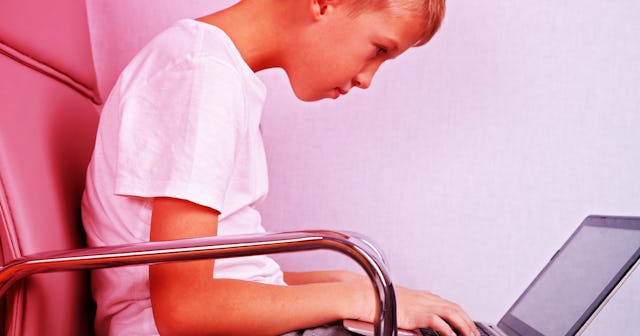Poor Posture In Kids Is About More Than Just Sitting Up Straight

I grew up hearing “sit up straight,” a line from my mother that was always followed be a gentle poke between my shoulder blades to remind me to bring my shoulders back. My mother would adjust my posture and then tell me that one day I’d thank her. I’d roll my eyes and inevitably, within a few minutes of the reminder, I’d be slouching again.
Now I have kids. And, as they say, history repeats itself. I constantly find myself reminding my tween daughter to stand straight, to put her shoulders back, to line her head up with her spine. She slouched before, but since the pandemic, her posture has taken a turn for the worse.
She’s not alone. With the shift to virtual everything early in the pandemic, kids were on screens more than ever—and in many cases, their posture suffered for it.
Ideal Posture For A Child
Posture is more than just “sitting up straight.” It’s how you hold your body whether standing, sitting, lying down, or moving. Good posture is important to lessen strain on the parts of your body that control those movements.
For kids, one way to check in with their posture is to see how they sit in a chair. Ideally, their back will be straight with their bottom all the way against the back of the chair. Their spine will show a natural S curve with shoulders coming slightly forward and a dip in the lower spine.
While standing, alignment becomes important. “Head, shoulders, hips, knees and ankles should all fall into one straight line,” according to an article in Children’s Health.
Keep in mind that perfect posture is a myth. In an article for Medium.com, René Phongam, DPT, noted that humans are all built differently and the right—or ideal—posture for one person will not be exactly right for another person.
Poor Posture Traits To Look Out For
fizkes/Getty
When I look at my daughter and her posture, I’m not just worried about slouching. I’m worried about slouching and the slightly forward head, the rounded shoulders—which all comes together to form the so-called “tech neck.” It’s most obvious in my daughter when she’s rounded over her phone. (I’m guilty of this posture, too. No doubt most of us are).
Other common poor posture traits Phongam is noticing in her practice include: tight hips, weak hamstrings, tilted forward pelvis, poor core strength, and shallow breathing.
Posture To Avoid Injuries
Learning and maintaining good posture is an investment in lifelong health. I’m trying to teach my daughter that paying attention to her posture now will pay off in the long run. (And not just because she’ll be free of my nagging—though I suspect that’s a big motivation for her.)
In an article for Children’s Health, Christopher Redman, M.D., a pediatric orthopedic surgeon with Children’s Health℠ Andrews Institute for Orthopaedics and Sports Medicine noted that, “Improper posture can lead to increased strain on the muscles, ligaments, joints and bones.” He said, “As a child is growing, bad posture can lead to abnormal positioning, abnormal growth of the spine and, ultimately, increased arthritis later in life.”
Phongam highlighted how misalignment can lead to an “increased disposition to injuries,” and “directly affects strength and flexibility gains.” Poor posture can affect your breathing and circulation, how you digest food, increase your risk of injury, and cause you to tire more quickly.
For better or worse, posture also plays a large role in how others see you and how you see yourself. One study found that better posture was linked to better self-esteem and mood.
Poor Posture Isn’t An Inevitability
We don’t really know the long-term effects of poor posture and “tech-neck” on kids. According to Cordelia Carter, M.D., pediatric orthopedic surgeon and director of the Pediatric Sports Medicine Center at Hassenfeld Children’s Hospital, “it could be just a strain on muscle and tendon — or it could affect how the body grows and develops.”
The good news is, even if your child is showing signs of poor posture, they aren’t doomed for a life of poor posture. There are ways to correct poor posture—at any age, really. (My posture didn’t improve until I found Pilates in my late twenties.)
Along with gentle reminders about posture from parents, activities that strength the back and shoulder muscles will help kids develop better posture habits. Screen time breaks will help, as will starting the day with a few stretches. Also, patience is key. Chances are kids won’t start practicing better posture after just a few days of focus.
If you’re really concerned, it’s always a good idea to check in with your pediatrician.
We all want to set our kids up for a healthy life, to do whatever we can to give them the best start. My own childhood poor posture and the work it took to correct it is always in the back of my mind when I talk to my daughter about her posture. It’s why whenever we set aside time to work on posture exercises, I say with full seriousness as she’s rolling her eyes at me, “One day you’ll thank me for this.”
And she will. I hope.
This article was originally published on